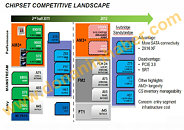Tuesday, November 8th 2011

AMD 1090FX and 1070 Chipsets Disclosed, No PCI Express 3.0
AMD is fine-tuning its product development cycle to deliver a new processor architecture towards the end of each year, and a new chipset towards the beginning of one, maintaining platform compatibility and longevity. The company launched its socket AM3+ compliant 9-series chipset months ahead of its first-generation Bulldozer FX processor family, though it looks like in the year 2012 it will launch a new line of desktop chipset, in all likelihood it will precede the launch of second-generation Bulldozer (codenamed "Piledriver") processors.
In 2012, AMD chipset family will be led by the 10-series chipset. At the very top is AMD 1090FX northbridge, followed by 1070. 1090FX will be designed to give out two PCI-Express x16 links, which can then drive up to four graphics cards. The 1070, on the other hand, gives out just one x16 link, which can drive up to two graphics cards. AMD will scrap its present model of 990X and 970, in which the northbridge is essentially the same piece of silicon, with the 990X having lane switches and supporting CrossFireX. A big revelation here is that the 10-series chipset will not feature PCI Express Gen 3.0. We'd normally expect AMD to be at the forefront of supporting new technologies. If we remember, AMD 790FX was the first AMD platform chipset in the industry to feature PCI-Express 2.0. Also, it is highly likely that AMD's Radeon HD 7000 series graphics, which are slated for later this year, will support PCI-Express 3.0 interface.On the upside, though, 10-series chipset will be backed by the new SB1050 southbridge, which outpaces Intel's 7-series chipset in terms of connectivity. To begin with, SB1050 will pack a massive 8-port SATA 6 Gb/s RAID controller. All ports will run support 6 Gb/s data-rate. The SB1050 will also integrate native USB 3.0 SuperSpeed controllers. They will also streamline inventory management for manufacturers, as the chipset will be compatible with existing processor platforms. Some industry sources we spoke to commented that PCI-Express 3.0 chipset support is unlikely till Piledriver processors start selling.
Source:
DonanimHaber
In 2012, AMD chipset family will be led by the 10-series chipset. At the very top is AMD 1090FX northbridge, followed by 1070. 1090FX will be designed to give out two PCI-Express x16 links, which can then drive up to four graphics cards. The 1070, on the other hand, gives out just one x16 link, which can drive up to two graphics cards. AMD will scrap its present model of 990X and 970, in which the northbridge is essentially the same piece of silicon, with the 990X having lane switches and supporting CrossFireX. A big revelation here is that the 10-series chipset will not feature PCI Express Gen 3.0. We'd normally expect AMD to be at the forefront of supporting new technologies. If we remember, AMD 790FX was the first AMD platform chipset in the industry to feature PCI-Express 2.0. Also, it is highly likely that AMD's Radeon HD 7000 series graphics, which are slated for later this year, will support PCI-Express 3.0 interface.On the upside, though, 10-series chipset will be backed by the new SB1050 southbridge, which outpaces Intel's 7-series chipset in terms of connectivity. To begin with, SB1050 will pack a massive 8-port SATA 6 Gb/s RAID controller. All ports will run support 6 Gb/s data-rate. The SB1050 will also integrate native USB 3.0 SuperSpeed controllers. They will also streamline inventory management for manufacturers, as the chipset will be compatible with existing processor platforms. Some industry sources we spoke to commented that PCI-Express 3.0 chipset support is unlikely till Piledriver processors start selling.

38 Comments on AMD 1090FX and 1070 Chipsets Disclosed, No PCI Express 3.0
And +1 for lesson learned with AMD - Never buy a chipset before CPU launch. Lol
I think the reason why AMD is so reluctant to upgrade the NB is bc the next step for them would be to integrate a fully new NB into the CPU. So I guess all the (limited) resources are going into that.
The plans for my current system involve 2 SSDs in RAID 0 and 4 HDDS in RAID 10, so I've maxed out my onboard SATA3 controller.
Intel X38 has been launched in 2007.09,
Nvidia 780a - 2008.05,
AMD 790X - 2007.11.
NVIDIA 780a was launched in May 2008. Google it.
AMD 790FX was launched around the same time as X38. I concede Intel was ahead with X38. Let me fix that part.
Not impressed. Course I'll reserve final judgement till it actually ships.
anyhoo when do we expect this to kick into the market? with piledriver or with the revised bulldozer chips?
www.tomshardware.com/reviews/990fx-sli-am3,2953.html
Thanks for bringing this to our attention btarunr
But the lack of PCIe 3.0 seems disappointing. AMD can try and say we have dual 16x slots with the 1090FX to Intel's dual 8x slots, but the Ivy Bridge chipsets will have PCIe 3.0, so dual 8x 3.0 ~ dual 16x 2.0.
the best example of what cdwall was saying is 775 compared to 1366, lower nm, higher wattage and higher heat.
a die shrink doesn't equate to heat output most of the time these days.
Something makes me feel like if they could tweak it a bit, then they would be able to do what they did with the Phenom to Phenom II rehash.
Not sure what is going on at AMD any more.
If you want an example of optical shrinks, don't look at Intel CPUs, look at NVIDIA GPUs. Clock-for-clock, G92b (55 nm) was cooler and drew less power than G92 (65 nm). There were no transistor count changes between them.